Transmission and Distribution: Unit V: (a) Distribution Systems
Flexible AC Transmission Systems (FACTS)
Advantages of - Objectives of - Types of
Questions : 1. Explain in detail various types of FACTS controllers. 2. State the advantages of FACTS based controllers. 3. What are the objectives of FACTS?
Flexible AC Transmission
Systems (FACTS)
In the modem power systems, the power
flow in the transmission lines can be controlled with the use of power
electronics. The Flexible AC Transmission System (FACTS) give solutions to the
problems and limitations which were introduced in the power system with the
introduction of power electronics based control for reactive power.
The FACTS technology making use of power
electronics pormotes the control of transmission line. It also increases load
on the line upto the thermal limits without having compromise with the
reliability. The line capacity is thus increased which improves reliability of
the system. Due to this, there is maximum utilisation of available equipments
and additional bulk power transfers are possible. This also avoids the
construction of new transmission lines which is time consuming process.
The FACTS based controllers gives
instantaneous control of transmission voltage and increases capacity providing
larger flexibility in bulk power transmission. It also helps in damping out
major grid oscillations. Tennessee Valley Authority (TVA) has installed the
first Static Synchronous Compensator (STATCOM) in the year 1995. This has
strengthen ties between Sulivan substation and the rest of the network.
1. Advantages of FACTS based Controllers
1. It controls line impedance angle and
voltage which helps in controlling the power flow in transmission lines.
2. The power flow in the transmission
lines can be made optimum.
3. It helps in damping out the
oscillations and avoids damage of various equipments.
4. It supports the power system security
by increasing the transient stability limit. It also limits overloads and short
circuit currents.
5. The reserve requirements for generators
are considerably reduced as these controllers provide secure and controllable
tie line connections to neighbouring electric utilities.
6. The loading capacity of the line is
greatly increased upto their thermal capabilities. Thus upgrading of lines is
possible.
7. It limits the impacts of faults and
equipment failures.
8. The reactive power flow in the lines
can be decreased and the lines are made to carry more active power.
9. There is increase in utilisation of
low cost generation due to cost effective enhancement of transmission line
capacity.
3. Objectives of FACTS
The concept of FACTS was established in
order to solve the problem which was emerging in power systems in the late
1980s as there are restrictions on the construction of transmission line and to
promote power growth of import and export.
The main objectives behind the FACTS
based controllers are
1. The power transfer capability of
transmission systems is to be increased.
2. The power flow is to be kept over the
designated routes.
The first objective indicates that the
power flow in a given transmission line can be increased upto its thermal
limit. This can be achieved by passing the required current through the series
line impedance and maintaining the stability of the system through the proper
real time control of power during and after system faults.
The second objective indicates that the
flow of power in the line can be restricted to select proper transmission
corridors by controlling current in the line.
If these two objectives are fullfilled
then there will be significant increase in the utilisation of new and existing
transmission lines. It will promote the deregulation of power system and there
will minimum requirements for new transmission lines. In order to implement
these objectives, high power compensators and controllers are required.
The concept of Flexible AC Transmission
Systems (FACTS) was first defined in 1988 by N.G. Hingorani. These controllers
control all the interrelated parameters which are involved in power system
operation such as series and shunt impedance, current, voltage and phase angle.
Also it damps the oscillations at various frequencies below the rated
frequency. Thus these controllers are advantageous to power systems in terms of
its operation, control, planning of lines and finance.
3. Types of FACTS Controllers
There are large number of types of FACTS
controllers with the recent advancement in power system. Some of these
controllers are already installed and put in operation while some of them are
still under construction. However more work is to be carried out in this area
so that new characteristics of these controllers can be fully used.
Presently FACTS highlight on power flow
control and modulation, operating devices, damping of oscillations and stability
enhancement. The basic symbol of FACTS controller is shown in the Fig. 7.28.1.
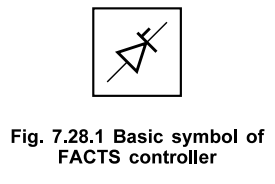
There are four main categories under
which FACTS controllers are divided.
a. Series Controllers
These type of controllers inject voltage
in series with the line. The current flowing through the line multiplied by
variable impedance represents injected series voltage in the line. Till the
time the voltage is in phase quadrature with the line current, these
controllers only supply variable reactive power. If there phase relationship
between voltage and current is different then real power is also handled in
addition to reactive power. A typical series FACTS controller is shown in the
Fig. 7.28.2.
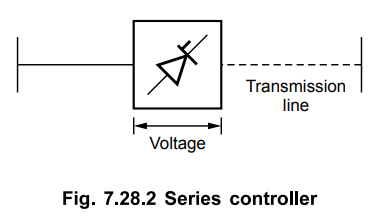
The series controller is normally of
variable impedance type such as capacitor, reactor or power electronics based
variable source of main, subsynchronous and harmonic frequencies to satisfy the
requirement.
b. Shunt Controllers
The shunt controllers inject current in
the system at the point of connection. The shunt controllers are of variable
impedance type, variable source type or a combination. The shunt type of FACTS
controller is shown in the Fig. 7.28.3.
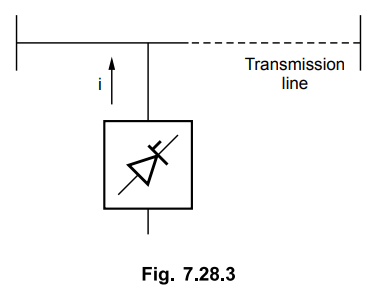
If a variable shunt impedance is
connected to line voltage, variable current flows and current is injected in
the line. So long as there is quadrature relationship between voltage and
current, these controllers either supply or deal with reactive power. For other
phase relationship, active power is also handled.
c. Combined Series Series Controllers
In these type of controllers, series
controllers are controlled in co-ordinated manner in case of multiline
transmission system. It is alternatively unified controller in which series
controllers individually supply reactive power compensation independently for
every line and also transfer real power among the lines through power link. The
meaning of the term unified indicates that the dc terminals of all the
controller converters are all connected together for transfering real power.
Such type of controller is shown in the
Fig. 7.28.4.
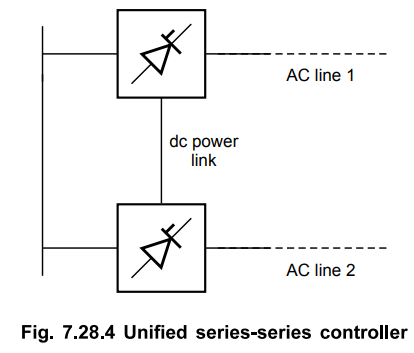
The capacity of these controllers to
transfer real power makes maximized utilisation of transmission system as it is
possible to balance both real and reactive power flow in the lines.
d. Combined Series-Shunt Controllers
It may be a combination of separate
series and shunt controllers which are controlled in a co-ordinated manner as
shown in the Fig. 7.28.5 (a) or a unified power flow controller with series and
shunt elements as shown in the Fig. 7.28.5 (b).
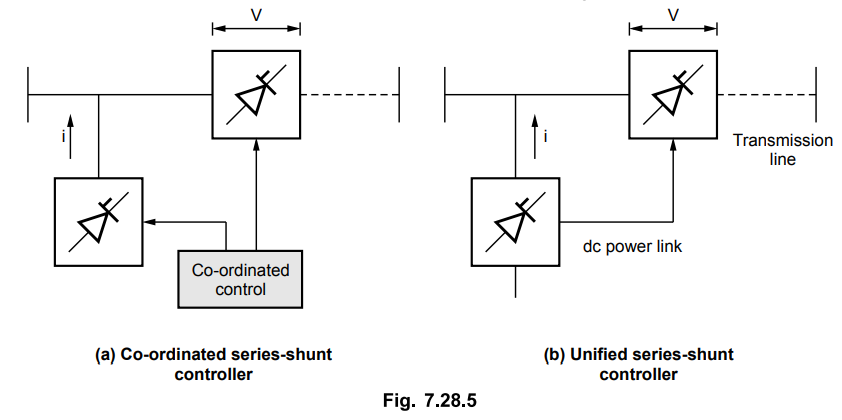
In these type of controllers, current is
injected in the system through shunt part of the controller while voltage is
injected in the line through series part of the controller. In unified
series-shunt controller, it is possible to exchange real power between series
and shunt controllers through dc power link.
Review Questions
1. Explain in detail various types of FACTS controllers.
AU: May-07, 10, 16, Marks 16
2. State the advantages of FACTS based controllers.
3. What are the objectives of FACTS?
AU: Dec.-13, Marks 2
Transmission and Distribution: Unit V: (a) Distribution Systems : Tag: : Advantages of - Objectives of - Types of - Flexible AC Transmission Systems (FACTS)
Related Topics
Related Subjects
Transmission and Distribution
EE3401 TD 4th Semester EEE Dept | 2021 Regulation | 4th Semester EEE Dept 2021 Regulation
